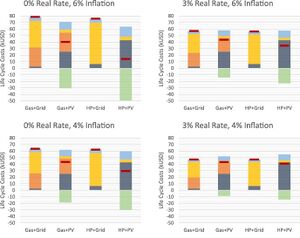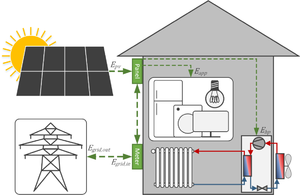
This study aims to quantify the techno-economic potential of using solar photovoltaics (PV) to support heat pumps (HP) towards the replacement of natural gas heating in a representative North American residence from a house owner’s point of view. For this purpose, simulations are performed on: (1) a residential natural gas-based heating system and grid electricity, (2) a residential natural gas-based heating system with PV to serve the electric load, (3) a residential HP system with grid electricity, and (4) a residential HP+PV system. Detailed descriptions are provided along with a comprehensive sensitivity analysis for identifying specific boundary conditions that enable lower total life cycle cost. The results show that under typical inflation conditions, the lifecycle cost of natural gas and reversable, air-source heat pumps are nearly identical, however the electricity rate structure makes PV costlier. With higher rates of inflation or lower PV capital costs, PV becomes a hedge against rising prices and encourages the adoption of HPs by also locking in both electricity and heating cost growth. The real internal rate of return for such prosumer technologies is 20x greater than a long-term certificate of deposit, which demonstrates the additional value PV and HP technologies offer prosumers over comparably secure investment vehicles while making substantive reductions in carbon emissions. Using the large volume of results generated, impacts on energy policy are discussed, including rebates, net-metering, and utility business models.

Highlights[edit | edit source]
- Techno-economic potential of photovoltaics (PV) to support heat pumps (HP)
- Compares (1) gas heating + grid electricity, (2) gas + PV, (3) HP + grid, and (4) HP + PV
- Electricity prices have the greatest influence on HP and PV
- High inflation rates strongly favor PV and by extension HP, acting as a cost hedge
- Policies and business models needed to support prosumer technology adoption
Keywords[edit | edit source]
Photovoltaic; Residential heating; Energy policy Distributed generation; Solar energy; hybrid system; heat pumps; electrification; renewable energy; northern climate; solar-assisted heat pumps; sustainable energy; net zero; greenhouse gas emissions
See also[edit | edit source]
- Economics of Grid-Tied Solar Photovoltaic Systems Coupled to Heat Pumps: The Case of Northern Climates of the U.S. and Canada
- Decarbonizing rural residential buildings in cold climates: A techno-economic analysis of heating electrification
- Emerging economic viability of grid defection in a northern climate using solar hybrid systems
- Levelized cost of electricity for solar photovoltaic, battery and cogen hybrid systems
- Performance of U.S. hybrid distributed energy systems: Solar photovoltaic, battery and combined heat and power
- The Potential for Grid Defection of Small and Medium Sized Enterprises Using Solar Photovoltaic, Battery and Generator Hybrid Systems
- Review of solar levelized cost
- Simulations of Greenhouse Gas Emission Reductions from Low-Cost Hybrid Solar Photovoltaic and Cogeneration Systems for New Communities
- Policies to Overcome Barriers for Renewable Energy Distributed Generation: A Case Study of Utility Structure and Regulatory Regimes in Michigan
- A review of the value of solar methodology with a case study of the U.S. VOS
- Examining interconnection and net metering policy for distributed generation in the United States
- Energy Policy for Energy Sovereignty: Can policy tools enhance energy sovereignty?
- Strategic Investment in Open Hardware for National Security
- Achieving 100% Renewable and Self-Sufficient Electricity in Impoverished, Rural, Northern Climates: Case Studies from Upper Michigan, USA
- Open source decarbonization for a sustainable world
- A Free and open-source microgrid optimization tool: SAMA the Solar Alone Multi-Objective Advisor




